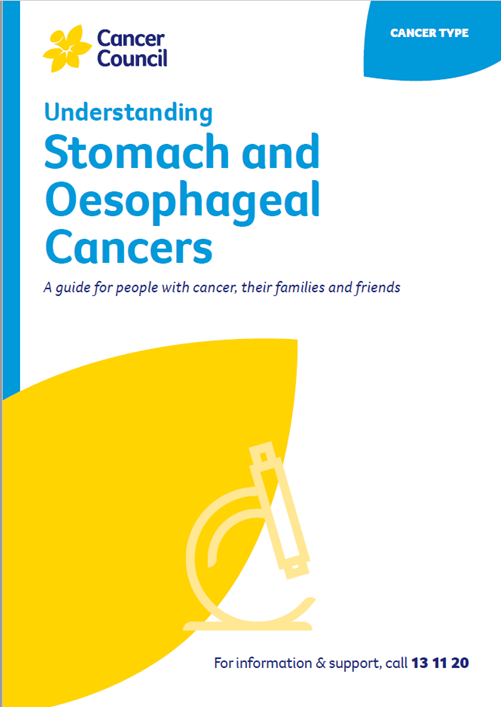- Home
- Oesophageal cancer
- Diagnosis
- Tests
Tests for oesophageal cancer
Checking for oesophageal cancer usually involves a number of tests. The diagnostic tests you have for oesophageal cancer will depend on your specific situation and may include:
- an endoscopy and biopsy to find oesophageal cancer
- further tests to see if the cancer has spread (metastasised).
Waiting for the test results can be a stressful time. It may help to talk to a friend or family member, or a health professional. You can also call Cancer Council 13 11 20.
Learn more about:
Endoscopy and biopsy
An endoscopy (also called a gastroscopy, oesophagoscopy or upper endoscopy) is a procedure that allows your doctor to look at the lining of your gastrointestinal tract. It is usually done as day surgery.
Having an endoscopy
You will be told not to eat or drink (to fast) for 6 hours before an endoscopy. In some cases, you can drink clear fluids until 2 hours before the procedure. Your doctor will let you know about this. To make the procedure more comfortable, you’re likely to be offered sedation to make you feel sleepy. A general anaesthetic is only needed for a small number of cases. Once the sedative has taken effect, a long, flexible tube with a light and small camera on the end (endoscope) will be passed into your mouth, down your throat and oesophagus, and into your stomach and small bowel.
Taking a biopsy
If the doctor sees any areas that look like cancer, they may remove a small amount of tissue from the stomach or oesophageal lining. This is called a biopsy. A specialist doctor called a pathologist will examine the tissue under a microscope to check for signs of cancer. Biopsy results are usually available in 2–3 working days.
An endoscopy takes about 10 minutes. You may feel drowsy or weak after the procedure, so will need to have someone take you home. You may have a sore throat and feel a little bloated for some time afterwards.
Endoscopies have some risks, such as bleeding or getting a small tear or hole in the stomach or oesophagus (perforation). These complications are very uncommon. Your doctor should explain all the risks before asking you to agree (consent) to the procedure.
Endoscopic ultrasound (EUS)
You may have an EUS at the same time as a standard endoscopy. The doctor will use an endoscope with an ultrasound probe on the tip or with a built-in ultrasound device. The probe releases soundwaves that echo when they bounce off anything solid, such as an organ or tumour. This test helps work out whether the cancer has spread into the oesophageal or stomach wall, nearby tissues or lymph nodes.
During the EUS, your doctor may use the ultrasound to guide a needle into the area they want to look at and take tissue samples.
→ READ MORE: Further tests for oesophageal cancer
Podcast: Tests and Cancer
Listen to more of our podcast for people affected by cancer
More resources
Prof David I Watson, Matthew Flinders Distinguished Professor of Surgery, Flinders University, and Senior Consultant Surgeon, Oesophago-Gastric Surgery Unit, Flinders Medical Centre, SA; Prof Bryan Burmeister, Senior Radiation Oncologist, GenesisCare Fraser Coast and Hervey Bay Hospital, QLD; Kieran Cahill, Consumer; Jessica Jong, Clinical Dietitian, Upper GI and Hepatobiliary Services, Peter MacCallum Cancer Centre, VIC; John Leung, Consumer; Prof Rajvinder Singh, Professor of Medicine, University of Adelaide, and Director, Gastroenterology Department and Head of Endoscopy, Lyell McEwin Hospital, SA; Dr Sarah Sutherland, Medical Oncologist, Chris O’Brien Lifehouse, NSW; Paula Swannock, Upper GI Cancer Nurse Consultant, St Vincent’s Hospital Melbourne, VIC; Rebecca Yeoh, 13 11 20 Consultant, Cancer Council Queensland.
View the Cancer Council NSW editorial policy.
View all publications or call 13 11 20 for free printed copies.

